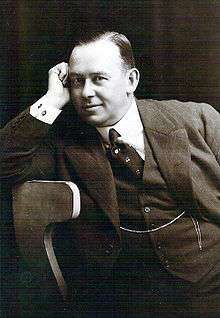Slapstick
Slapstick is a style of humor involving exaggerated physical activity that exceeds the boundaries of normal physical comedy.[1][2] Slapstick may involve both intentional violence and violence by mishap, often resulting from inept use of props such as saws and ladders.[3][4]
.jpg)
The term arises from a device developed for use in the broad, physical comedy style known as commedia dell'arte in 16th-century Italy. The "slap stick" consists of two thin slats of wood, which make a "slap" when striking another actor, with little force needed to make a loud—and comical—sound. The physical slap stick remains a key component of the plot in the traditional and popular Punch and Judy puppet show.
Origins
The name "slapstick" originates from the Italian Batacchio or Bataccio – called the "slap stick" in English – a club-like object composed of two wooden slats used in commedia dell'arte. When struck, the Batacchio produces a loud smacking noise, though it is only a little force that is transferred from the object to the person being struck. Actors may thus hit one another repeatedly with great audible effect while causing no damage and only very minor, if any, pain. Along with the inflatable bladder (of which the whoopee cushion is a modern variant), it was among the earliest special effects.
Early uses
_(14578297507).jpg)
Slapstick comedy's history is measured in centuries. Shakespeare incorporated many chase scenes and beatings into his comedies, such as in his play The Comedy of Errors. In early 19th-century England, pantomime acquired its present form which includes slapstick comedy, while comedy routines also featured heavily in British music hall theatre which became popular in the 1850s.[5][6]
In Punch and Judy shows, which first appeared in England on 9 May 1662, a large slapstick is wielded by Punch against the other characters.[7]
Fred Karno

British comedians who honed their skills at pantomime and music hall sketches include Charlie Chaplin, Stan Laurel, George Formby and Dan Leno.[8][9] The influential English music hall comedian and theatre impresario Fred Karno developed a form of sketch comedy without dialogue in the 1890s, and Chaplin and Laurel were among the young comedians who worked for him as part of "Fred Karno's Army".[8] Chaplin's fifteen-year music hall career inspired the comedy in all his later film work, especially as pantomimicry.[10] In a biography of Karno, Laurel stated: "Fred Karno didn't teach Charlie [Chaplin] and me all we know about comedy. He just taught us most of it".[11] American film producer Hal Roach described Karno as "not only a genius, he is the man who originated slapstick comedy. We in Hollywood owe much to him."[12]
In film and television
_03.jpg)
Building on its later popularity in the 19th and early 20th-century ethnic routines of the American vaudeville house, the style was explored extensively during the "golden era" of black and white, silent movies directed by figures Mack Sennett and Hal Roach and featuring such notables as Charlie Chaplin, Mabel Normand, Laurel and Hardy, the Marx Brothers and the Keystone Cops. Silent slapstick comedy was also popular in early French films and included films by Max Linder, Charles Prince, and Sarah Duhamel.[13]
Slapstick also became a common element in animated cartoons starting in the 1930; examples include Disney's Goofy shorts, Walter Lantz's Woody Woodpecker and The Beary Family, MGM's Tom and Jerry, the unrelated Tom and Jerry cartoons of Van Beuren Studios, Warner Bros. Looney Tunes/Merrie Melodies, MGM's Barney Bear, and Tex Avery's Screwy Squirrel.
Slapstick was later used in Japanese Tokusatsu TV Kamen Rider Drive and in the United States used in the two 1960s TV series, Gilligan's Island, and Batman.
Contemporary presence
Slapstick continues to maintain a presence in modern comedy that draws upon its lineage, running in film from Buster Keaton and Louis de Funès to Jerry Lewis and Mel Brooks to the television series Jackass and comedy movies by the Farrelly Brothers, and in live performance from Weber and Fields to Jackie Gleason to Rowan Atkinson. In England, slapstick was a main element in television series such as Fawlty Towers and The Benny Hill Show. Slapstick has remained a popular art form to the present day including The Simpsons and the hit web-cartoon CartoonMania "Slapstick is a concept that occurs in most classic cartoons. Animating it is not easy though, it's more complicated than setting up a mousetrap."
See also
- List of slapstick comedy topics
- Slapstick film
- Physical comedy
- Stage combat
- Schadenfreude
- Harisen, a paper fan used by the Japanese for a similar purpose.
References
| Look up slapstick in Wiktionary, the free dictionary. |
- "slapstick - definition of slapstick by the Free Online Dictionary, Thesaurus and Encyclopedia". Thefreedictionary.com. Retrieved 2013-04-29.
- "Slapstick Comedy - film, cinema". Filmreference.com. Retrieved 2013-04-29.
- King, Rob (2017). Hokum!: The Early Sound Slapstick Short and Depression-Era Mass Culture. Oakland, California: University of California Press. p. 197.
- "Slapstick comedy definition of Slapstick comedy in the Free Online Encyclopedia". Encyclopedia2.thefreedictionary.com. Retrieved 2013-04-29.
- David Christopher (2002). British Culture: An Introduction. p. 74. Routledge,
- Jeffrey Richards (2014). The Golden Age of Pantomime: Slapstick, Spectacle and Subversion in Victorian England. I.B.Tauris,
- Miller, Judith (2017). Miller's Antiques Handbook & Price Guide 2018-2019. Hachette UK. p. 351.
- McCabe, John. "Comedy World of Stan Laurel". p. 143. London: Robson Books, 2005, First edition 1975
- "Enjoy Cumbria - Stan Laurel". BBC. Retrieved 2 January 2015
- St. Pierre, Paul (2009). Music Hall Mimesis in British Film, 1895-1960: On the Halls on the Screen. Associated University Press. p. 38.
- Burton, Alan (2000). Pimple, pranks & pratfalls: British film comedy before 1930. Flicks Books. p. 51.
- J. P. Gallagher (1971). "Fred Karno: master of mirth and tears". p. 165. Hale.
- Maggie Hennefeld "Specters of Slapstick and Silent Film Comediennes", Columbia UP, 2018.